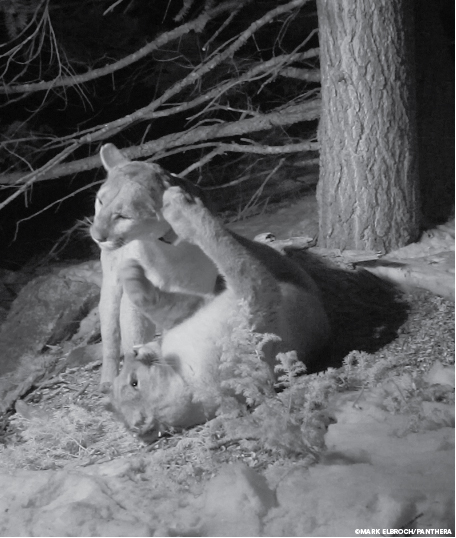Pumas, long known as solitary carnivores, are more social than previously thought, according to a study led by conservation organization Panthera and co-authored by UC Davis and the American Museum of Natural History.
The study, published today in the journal Science Advances, is the first to quantify complex, enduring, and “friendly” interactions of these secretive animals, revealing a rich puma society far more tolerant and social than previously understood.
"Our research shows that food sharing among this group of mountain lions is a social activity, which cannot be explained by ecological and biological factors alone," said co-author Mark Lubell, director of the UC Davis Center for Environmental Policy and Behavior.
The findings may have implications for multiple species, including other wild cats around the world.
“It’s the complete opposite of what we’ve been saying about pumas and solitary species for over 60 years,” said lead author Mark Elbroch, lead scientist with the Panthera Puma Program. “We were shocked. This research allows us to break down mythologies and question what we thought we knew.”
Not so solitary
Pumas have been assumed to avoid each other, except during mating, territorial encounters, or when raising young. The population studied interacted every 11-12 days during winter. That is much less frequent than more gregarious species like meerkats, African lions, or wolves, which interact as often as every few minutes. To document social behavior, the scientists had to follow pumas over longer time spans.

The team collected thousands of locations in northwest Wyoming from GPS-equipped collars and documented the social interactions of pumas over 1,000 prey carcasses. Of those studied, 242 were equipped with motion-triggered cameras that filmed interactions and served as evidence of social behavior.
“Suddenly, I was able to see what was happening when these animals were coming together,” Elbroch said. “By stepping back, we captured the patterns of behavior that have no doubt been occurring among pumas all along.”
The research team analyzed puma networks to reveal that the species exhibits social strategies like more social animals, just over longer timescales.
Study highlights
- Each puma shared food with another puma at least once during the study, and many of them ate with other pumas many times.
- Choosing individuals to share meals with was not random or reserved for family members. The pumas seemed to recall who shared food with them in the past—and were 7.7 times more likely to share with those individuals. This is usually only documented with social animals.
- Males and females likely benefit differently from social interactions. Males received more free meat than females, while females likely received social investments facilitating mating opportunities.
- Territorial males acted like governors of fiefdoms, structuring how all pumas across the landscape interacted with each other. All pumas living inside each male territory typically formed a single network and were more likely to share their food with each other. Social interactions occurred across these borders, but much less frequently than among cats within the same male territory.
Loss of males disruptive to social network
The study emphasizes that puma populations are composed of numerous smaller communities ruled by territorial males. The loss of males, whether by natural or human causes, potentially disrupts the entire social network.
Except for lions and cheetahs, whose males form long-term social groups, all wild cats are typically described as solitary — a strategy characteristic of species living in complex habitats where predators compete for dispersed prey. This study could encourage researchers to study the social behavior of other solitary carnivores.
“This opens the door to enormous possibilities,” Elbroch said. “Are pumas everywhere behaving the same, or only in areas with large prey? Are other species like leopards and wolverines and so many others acting the same way? There is so much more to discover about the rich, secret social lives of wild creatures.”
